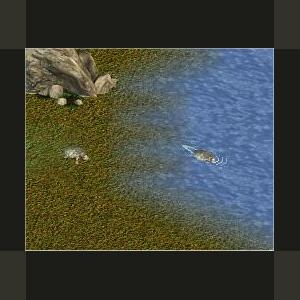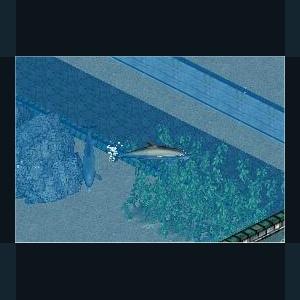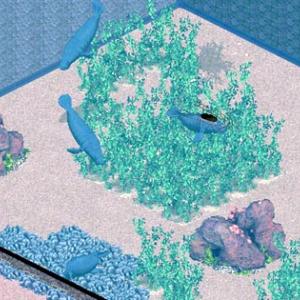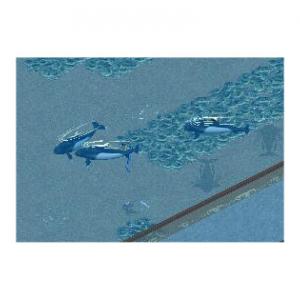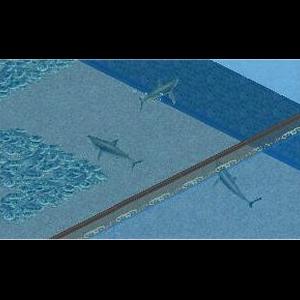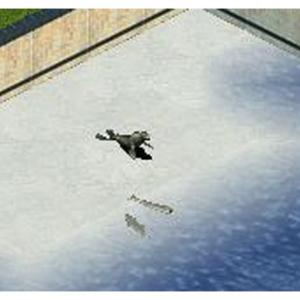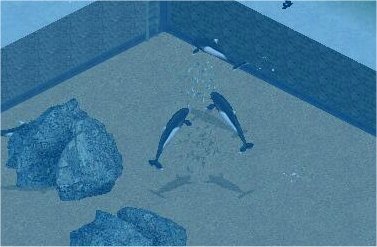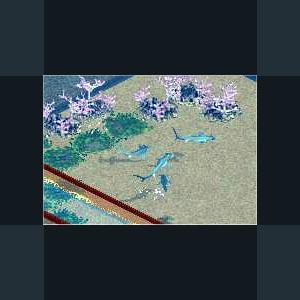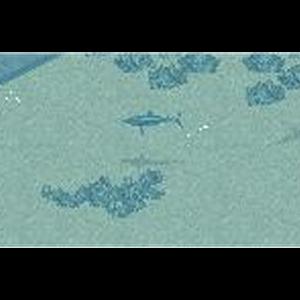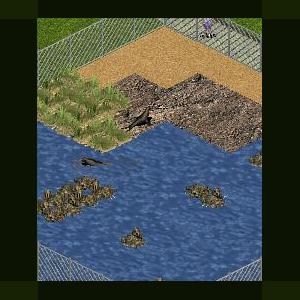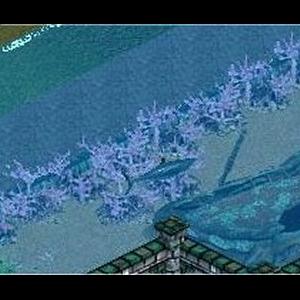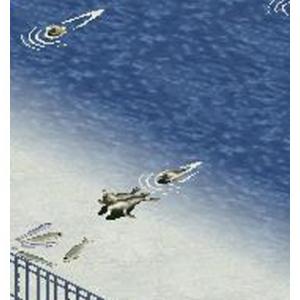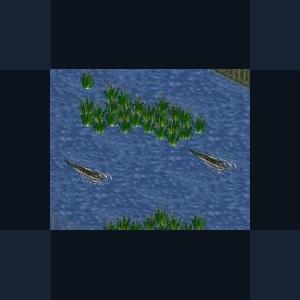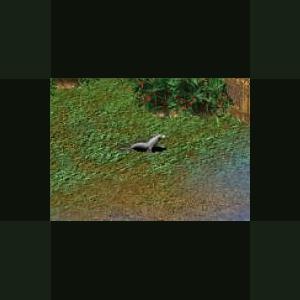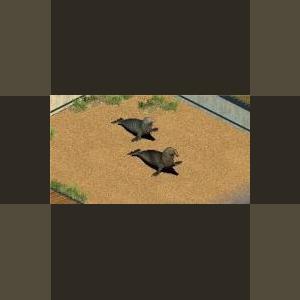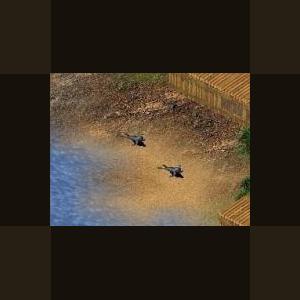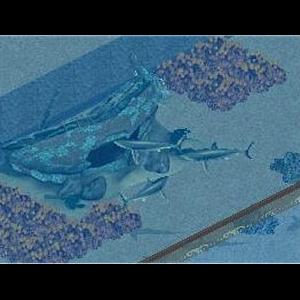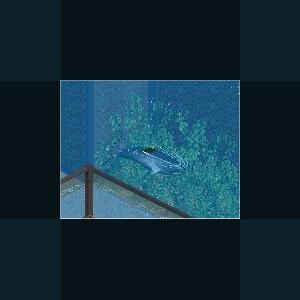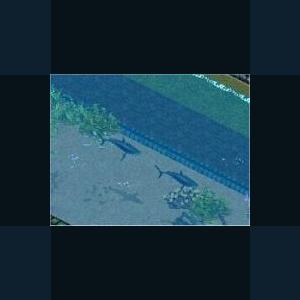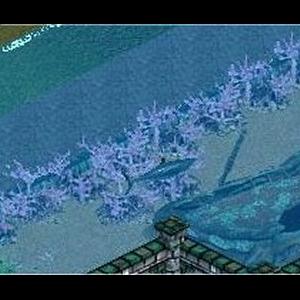Marine
Creatures under the sea
47 files
-
Western Pond Turtle by Ghirin
By Guest
Western Pond Turtle
Author: Ghirin
The western pond turtle is native to the Pacific Northwest of North America. Its preferred habitat is near streams, rivers and slow-moving bodies of water. The diet includes insects, small fish, and frogs.
Created by Ghirin 2005
548 downloads
Updated
-
Pacific Baracuda by BigCatKeeper
By Guest
Pacific Barracuda Author: BigCatKeeper
The Pacific barracuda is slim-bodied, has a tapered head, a long thin snout, and large canine teeth in a lower jaw that projects beyond the upper. It also has a forked tail, large eyes, and short, widely separated dorsal fins with 5 dorsal spines and 10 dorsal rays. The anal fins have 2 spines followed usually by 9 rays. Greyish-black on the back with a blue tinge, shading to silvery white on the sides and belly, it has a yellowish tail which lacks the black blotches on the sides of the body that are characteristic of other barracudas. Large females have a charcoal black edge on the pelvic and anal fins, whereas the male fins are edged in yellow or olive.
The Pacific barracuda is shorter than the great barracuda. It reportedly can grow up to 5 feet but has only been recorded to 4 feet; it rarely weighs more than 10 pounds, and though fish of about 12 pounds have been captured, most of the fish caught by anglers are much smaller. They grow to at least 11 years old, and the females grow larger than the males, with most fish over 8 pounds and all fish over 11 pounds being female. The growth rate is similar in both sexes until the fourth year of life, when the females begin to grow a bit faster. Pacific barracudas occur along the Pacific coast of North America from Alaska to Magdalena Bay, Baja California, though their common range is between Point Conception, California, and Magdalena Bay. The Pacific barracuda is the only barracuda found along the Pacific coast of North America. Pacific barracudas prefer warmer water. Only caught off of California during the spring and summer, they are caught in Mexican waters throughout the year, reflecting a northerly spring migration and a southerly fall migration. Spawning takes place off outer Baja California in the open ocean, peaking in June but extending from April to September. The eggs are pelagic and once they hatch, the young come inshore and stay in the shallow, quiet bays and coastal waters while they grow. By July, fry spawned in early spring are about 4 inches and average about 16 inches a year later. A few males spawn in their first year, and all by their second year, while most females spawn in their second year and all by their third year. When small, they travel in schools, though adults are normally solitary. They are naturally curious and attracted to shiny objects.
The Pacific barracuda feeds by sight instead of smell, and eats small anchovies, smelt, squids, and other small, schooling fish.
Pacific Barracuda created by Bigcatkeeper
Idea from Zoo Tycoon Brains Trust (Professorpaul)
Updated : August 3, 2009 by genki to fix the following:
- Cleaned up file
- Made corrections to the .uca to fix warnings that were coming up on the .uca checker
- Fixed LCID error, which can cause game crashes for some people
- Removed unneeded .wav files (was already linked to in-game sounds)
Update 8 August 2013 to add back the 2009 update info
389 downloads
0 comments
Updated
-
Delphin by Ghirin
By Guest
Delphin by Ghirin
Delphin (called Delphinus by the Romans) was the dolphin companion of the Greek god Poseidon. Today, Delphin is found among the stars as the constellation Delphinus.
272 downloads
0 comments
Updated
-
West African Manatee by BigCatKeeper
By Guest
West African Manatee Author: BigCatKeeper
http://www.zoo-tek.com/forums/index.php?download=167
Manatees are large, cylindrically shaped mammals, with forelimbs modified in to flippers, no free hind limbs, and the rear of the body in the form of a flat, rounded, horizontal paddle. The flexible flippers are used for aiding motion over the bottom, scratching, touching and even embracing other manatees, and moving food into and cleaning the mouth. Its upper lip is modified into a large bristly surface, which is deeply divided. It can move each side of the lips independently while feeding. The general coloration is grey.
The West African manatee weighs less than 500 kg (1100 lb). Adults are generally 3 - 4 m (10 - 13') long. It inhabits coastal areas, estuarine lagoons, large rivers that range from brackish to fresh water, freshwater lakes and the extreme upper reaches of rivers above cataracts. This manatee species is dependent on emergent or overhanging, rather than submerged, vegetation. Populations in some rivers depend heavily on overhanging bank growth, and those in estuarine areas feed exclusively on mangroves. Seasonal movements in response to changes in water level affecting availability of food and/or water salinity have been reported in several areas. An individual manatee may travel 30 - 40 km/day (19 - 25 mi/day) through lagoons and rivers.
The West African manatee occurs from Senegal to Angola; its numbers continue to decrease. The population decline has been attributed largely to hunting and incidental capture in fishing nets. Despite legal protection, the manatee is still hunted throughout its range. It is sometimes also killed in turbines or control gates of dams. The coastal wetlands that are a major habitat for the manatee have already been heavily damaged and are further severely threatened. Woodcutting is resulting in the extermination of mangrove stands in some areas. Mangrove clearance, as well as erosion due to forest clearance upstream, are resulting in increased sedimentation that silts up lagoons and estuaries.
West African Manatee created by Bigcatkeeper
Many thanks to Professorpaul
464 downloads
0 comments
Updated
-
Commersons Dolphin by Ghirin
By Guest
Commerson’s dolphin (Cephalorhynchus commersonii), also known as the piebald dolphin, is native to coastal waters of the southwestern Atlantic Ocean. (A second population has been identified in the Indian Ocean.) This dolphin is easy to recognize due to its striking black and white skin pattern. Young are born grey and become two-toned with age.
Commerson’s dolphins prefer coastal waters where the continental shelf is wide and flat. Their diet consists of squid, crustaceans, and fish. They usually travel in small groups of two to four animals, but large schools have been reported.
*Inspired by the Zoo Tycoon Brains Trust at the Zoo Tek Forums.
References:
Walker’s Mammals of the World. Nowak, 1999.
Animal: The Definitive Visual Guide the World’s Wildlife. Burnie and Wilson, 2001.
http://www.bbc.co.uk/nature/wildfacts/factfiles/79.shtml
Created by Ghirin 2004
413 downloads
0 comments
Updated
-
Pig-Nosed Turtle by Ghirin
By Guest
The pig-nosed turtle (Carettochelys insculpta), also known as the Fly River turtle, is a unique species of freshwater turtle native to northern Australia and southern New Guinea. The turtle gets its name from the way its nostrils are located in the front of its snout.
Even though the pig-nosed turtle is a freshwater turtle, it resembles a sea-going turtle because it has flippers instead of front legs. These turtles have been found in a variety of habitats, including rivers, estuaries, lagoons, lakes, swamps and water pools. The waterway bottoms are usually covered with gravel and the banks are usually heavily forested.
Pig-nosed turtles are omnivorous, but have a preference for fruit and leaves.
References:
http://www.tortoise.org/archives/pignose.html
http://www.whozoo.org/Intro2002/RacheLoftin/RNL_flyriverturtle.html
http://www.chelonia.org/carettochelys_gallery.htm
Created Ghirin 2005
452 downloads
0 comments
Updated
-
Bronze Whale by Ghirin
By Guest
The bronze whaler (Carcharhinus brachyurus) is found in open seas as well as coastal areas and reefs. It is thought to feed on fish, small sharks and cephalopods.
Female bronze whalers give birth to 13-20 live young which can then live independently.
*Inspired by the Zoo Tycoon Brains Trust at the Zoo Tek Forums.
Reference:
Sharks, Ferrari and Ferrari. 2002.
Ghirin 2005
400 downloads
0 comments
Updated
-
Hooded Seal by Ghirin
By Guest
The hooded seal (Cystophora cristata) occurs mainly in the northern Atlantic ocean from Newffoundland to Greenland. Individuals have been reported as far west as iceland and as far south as Florida. The hooded seal gets it name from the enlarged, inflatable nose of the male. To inflate the hood, the male closes his nostrils and fills his nose with air. The male can also blow a bright red ballon (made from the nasal septum) out of one nostril instead of inflating the hood. Females also have a hood, but it smaller and is not inflatable.
Hooded seals prefer to live in deep water areas where there is thick floating ice. During early spring, females haul out on the sea ice to give birth to their pups. This is also the mating season, when males display to the females, using their hoods as threats to rival males.
Hooded seals feed on fish, cephalopods, shrimp, and mussels.
References:
Walker's Mammals of the World, Nowak, 1999
http://www.bbc.co.uk/nature/wildfacts/factfiles/602.shtml
Photograph:
http://www.americazoo.com/goto/index/mammals/330.htm
Created by Ghirin 2003
308 downloads
0 comments
Updated
-
Dall's Porpoise by Ghirin
By Guest
Dall’s porpoise (Phocoenoides dalli), also known as the white-flanked porpoise, is a robust porpoise with a striking black and white piebald pattern. It is reported to be a fast cetacean (reaching speeds up to 55 km/hr for short periods) and regularly rides the bow waves of ships when the vessel is moving at a minimum of 26 km/hr. Dall’s porpoises are also known for sending up “rooster-tail” water sprays when they surface.
Dall’s porpoises are native to the northern Pacific Ocean and range from Japan to California. Unlike several other porpoise species, Dall’s porpoise is regularly reported in open oceanic waters. It often forms groups of two to twelve individuals, but these small schools have been known to merge into groups of several thousand.
Their diet consists mainly of squid, fish, and krill.
*Inspired by the Zoo Tycoon Brains Trust at the Zoo Tek Forums.
References:
Walker’s Mammals of the World. Nowak, 1999.
Animal: The Definitive Visual Guide the World’s Wildlife. Burnie and Wilson, 2001.
http://www.bbc.co.uk/nature/wildfacts/factfiles/128.shtml
Updated August 18, 2018 by Cricket so that screenshot would show up again.
Created by Ghirin 2004
363 downloads
0 comments
Updated
-
Bonnethead Shark by Ghirin
By Guest
The bonnethead shark (Sphyrna tiburo) is one of the the smallest members of the hammerhead shark family. These small sharks prefer tropical and subtropical coastal regions where there is continental shelf and are exclusive to the western hemisphere. Bonnethead sharks migrate to warmer waters during the winter months.
Bonnethead sharks are easy to distinguish from other hammerheads by the shape of their heads, which is more shovel-shaped than other hammerhead species. Their diet consists of crustaceans such as blue crabs and shrimp, mollusks, and small fishes. Females tend to consume more food, possibly to provide energy for reproduction.
This species of shark usually forms schools of up to fifteen individuals and they use their cerebrospinal fluid for communication between individuals. During birthing season (these sharks are livebearers), females predominate in shallow waters.
*Inspired by the Zoo Tycoon Brains Trust at the Zoo Tek Forums.
References:
-Hessing, S. 2000. "Sphyrna tiburo" (On-line), Animal Diversity Web. http://animaldiversi...rna_tiburo.html.
-Bester, C. "Bonnethead" (On-line), Florida Museum of Natural History.
http://www.flmnh.ufl...Bonnethead.html
Created by Ghirin 2004
699 downloads
Updated
-
Fresh Water Bull Shark by Ghirin
By Guest
The bull shark (Carcharhinus leucas) is a large, robust shark found in shallow coastal marine waters worldwide. These sharks will also enter and live in estuaries, freshwater lakes and rivers.
Bull sharks eat both bony fishes and small sharks. In the cooler portions of their range, bull sharks mate during the summer months; however, in the warmer parts of their range they may breed year-round. Females nourish the young internally for 10 to 11 months and give birth to free-swimming pups.
*Inspired by the Zoo Tycoon Brains Trust at the Zoo Tek Forums.
Reference:
http://www.flmnh.ufl.edu/fish/Gallery/Descript/bullshark/bullshark.htm
Created by Ghirin 2004
476 downloads
0 comments
Updated
-
Galapogos Sea Lion by Jordan MK
By Guest
Genus: Zalophus
Species: californianus wollebaeki
Identification:
There are three subspecies of Zalophus californianus. The California sea lion (Z. c. californianus) is found from southern Mexico up to British Columbia and breeds almost entirely on islands in southern California, western Baja California and the Gulf of California. The Galápagos sea lion (Z. c. wollebaeki) is found on the Galápagos Islands and also occasionally in coastal Ecuador and Colombia. The Japanese sea lion (Z. c. japonicus) is now believed to be extinct but was formerly found in the Sea of Japan. Some scientists believe that these three subspecies should in fact be classed as separate species, namely Z. californianus, Z. wollebaeki, and Z. japonicus.
Population:
There is no up-to-date count of Galápagos sea lions, the last reported population estimate of 30,000 being made in the late 1970s.
Endangerment Status:
The Galápagos sea lion is listed as Vulnerable on the IUCN Red List. This subspecies was not subjected to the same commercial exploitation that caused the depletion of California sea lion populations, although occasional sea lions were killed for their skins or to provide tooth necklaces for tourists. Many Galápagos sea lions have been and are still being killed as a result of illegal and local fishing activities around the islands, despite the Ecuador government expanding the no-fishing zone around the islands from 15 to 40 nautical miles in early 1998. The entanglement of sea lions in fishing gear, particularly in long-line hooks and nylon line, is one of the most important problems currently affecting the subspecies. Entanglement in marine debris is an additional problem. Between 1995 and November 2000 a total of 111 reports of entangled sea lions were received.
El Nino:
Galápagos sea lions are badly affected by the lack of food availability and weather conditions produced by El Niño events. During the 1982-83 El Niño all Galápagos sea lion pups born in 1982 died, while only a third of the normal number of pups were born in 1983. During the 1997-98 El Niño, the Galápagos sea lion population showed a significant decline in almost all of its colonies, a 48% population decrease caused by both mortality and migration having been observed during this period. The most affected age range were pups born between June 1997 and December 1998, suffering a 90% mortality rate. The large male sea lions, especially the dominant sea lions during the 1998 breeding season, experienced a 67% mortality rate. During the El Niño event it was found that the sea lions tried to make up for the lack in prey by feeding on lantern fish (Myctophidae) rather than the usual sardines (Clupeidae), and exhibited behavioural changes such as foraging during the night. The mortality rates indicate however that this modification in foraging behaviour was not enough to protect the population from the effects of the event. A recovery in the Galápagos sea lion population has been observed during 1999 and 2000, with an estimated 10% increase in the population. Pups born during the 1999-2000 breeding season were observed to be in good condition.
Reproduction:
Pups are born and breeding takes place on the sandy and rocky beaches of the Galápagos Islands from May - January, the timing varying from island to island. About 4-7 days after her pup is born, the mother leaves to feed at sea, thus beginning a cycle of feeding during the day, mainly at depths of 20-60m, and returning most nights to feed her pup. The pup can be nursed for as little as 6 months, but is often nursed for a year until the next pup is born. Some mothers have been known to nurse both their new pup and old pup for periods of up to a year. It is also occasionally known for mothers to nurse a single pup for up to 3 years, as long as they do not give birth to a new pup during this period. Galápagos sea lions do not migrate, remaining around the islands all year and feeding at shallow depths, mainly for sardines.
Created by JordanMK
331 downloads
Updated
-
Galapogos Shark by Ghirin
By Guest
The Galapagos shark (Carcharhinus galapagensis) is a common resident in the coastal waters of many tropical islands. This shark prefers shallow waters but has been known to swim in the deep water between islands. They are usually found near coral reefs.
Galapagos sharks feed on bottom-dwelling fishes such as flatfish and triggerfish. It is a viviparous species with litter sizes ranging from 6 to 16 pups. The young sharks form “nurseries” in shallow water to avoid predation by larger sharks.
This shark is known for its display when it feels threatened. The back is arched, the head is raised, and the pectoral and tail fins are lowered. The shark then swims in a twisting, rolling motion.
*Inspired by the Zoo Tycoon Brains Trust at the Zoo Tek Forums.
References:
http://www.shark.ch/cgi-bin/Sharks/spec_conv.pl?E+Carcharhinus.galapagensis
http://www.flmnh.ufl.edu/fish/Gallery/Descript/GalapagosShark/Galapagosshark.html
Created by Ghirin 2004
393 downloads
0 comments
Updated
-
Harp Seal by Ghirin
By Guest
The harp seal (Phoco groenlandica) is native to the north Atlantic ocean, ranging from the Gulf of St. Lawrence to Greenland. The fur of the seals changes with the age of the seal. The coat of the pup is white, turning gray after a few weeks. The adult coat has a background color of silvery gray with dark markings on the head and a dark band running up each flank and over the back that resembles a horseshoe or a harp.
The harp seal spends most of its time in the open sea or on ice. In the spring, the harp seals haul out on the sea ice for moulting, birthing pups, and breeding. Large numbers of seals may come together during this time.
Harp seals feed on fish and crustacenas. They bite breathing holes into the ice so that they have access to fresh air between dives for food.
References:
http://www.pagophilus.org/harpseals.htm
http://www.bbc.co.uk/nature/wildfacts/factfiles/166.shtml
Walker's mammals of the World, Nowak, 1999
Photograph:
http://www.pagophilus.org/birth.htm
Created by Ghirin 2003
394 downloads
0 comments
Updated
-
Orinoco Crocodile by Ghirin
By Guest
Orinoco Crocodile by Ghirin
The Orinoco crocodile (Crocodylus intermedius) is one of the largest predators found in South America.
At one time, this crocodile ranged from the northern coast of South America to the foothills of the Andes Mountains, but today its numbers have been severely reduced and it is critically endangered.
**Inspired by the Zoo Tycoon Brains Trust at the Zoo Tek Forums.
Reference:
http://www.flmnh.ufl.edu/natsci/herpetolog...cs/csp_cint.htm
381 downloads
0 comments
Updated
-
Nerpa Baikal Seal by Ghirin
By Guest
The nerpa or Lake Baikal seal (Pusa sibirica) is one of the smallest true seals in the world. This species of seal is native to Lake Baikal in Siberia and spends its entire life in freshwater.
296 downloads
0 comments
Updated
-
Hawaiian Monk Seal by Ghirin
By Guest
Hawaiian monk seals (Monochus schauinslandi) are found in the outer islands of the Hawaiian chain. Their genus, Monachus, is the only seal genus found in the tropics.
412 downloads
0 comments
Updated
-
Southern Elephant Seal by Ghirin
By Guest
The southern elephant seal (Mirounga leonina) is the largest living species of pinniped. This large seal is native to the sub-antarctic region.Elephant seals feed on fish and squid. They are know for their long, deep dives in search of prey.
447 downloads
0 comments
Updated
-
Caspian Seal by Ghirin
By Guest
The Caspian seal (Pusa caspica) is one of the smallest true seals in the world. It is native to the brackish waters of the Caspian Sea.
The Caspian seal is thought to be derived from the ringed seal of the Arctic and is close relative of the Siberian nerpa.
References:
http://en.wikipedia.org/wiki/Caspian_Seal
http://www.caspianenvironment.org/biodb/eng/mammals/Phoca%20(Pusa)%20caspica/main.htm
Created by Ghirin 2008
445 downloads
0 comments
Updated
-
Sicklefin Lemon Shark by Ghirin
By Guest
Sicklefin Lemon Shark Author: Ghirin
The sicklefin lemon shark (Negaprion acutidens) is a close relative of the lemon shark. The primary differences between the species are geographic location and fin shape. Sicklefin lemon sharks are native to the Pacific Ocean and their pectoral fins are more curved.
References:
Sharks, Ferrari and Ferrari. 2002
Ghirin 2005
281 downloads
0 comments
Updated
-
Lemon Shark by Ghirin
By Guest
Lemon Shark Author: Ghirin
The lemon shark (Negaprion brevirostris) is a large shark that inhabits the coastal waters of the Atlantic ocean, primary the coasts of the Americas and western Africa. A second population is also found in the Pacific coastal waters off of North and South America.
Lemon sharks form loose, same-sex groups that may come inshore during the day, but usually return to deeper waters at night. They are often found near the bottoms of of the bodies of water where they feed on bony fishes and crustaceans.
This species of shark is viviparous, giving birth to live pups (litter size ranges 4-17 pups). The pups live in shallow waters for the first years before venturing out into deeper waters.
*Inspired by the Zoo Tycoons Brains Trust at the Zoo Tek Forums
Created by Ghirin 2004
378 downloads
0 comments
Updated
-
Shortfinned Pilot Whale by Ghirin
By Guest
Short-finned Pilot Whale by Ghirin
The short-finned pilot whale (Globicephala macrorhynchus) is a large member of the dolphin family.
It is extremely social and usually travels in large groups.
References:
http://www.acsonline.org/factpack/PilotWhale.htm
www.wikipedia.org
*Inspired by the Zoo Tycoon Brains Trust at the Zoo Tek Forums*
477 downloads
0 comments
Updated
-
Porbeagle by Ghirin
By Guest
Porbeagle Shark Author: Ghirin
http://www.zoo-tek.com/forums/index.php?download=142
The porbeagle (Lamna nasus), also known as the Atlantic mackerel shark and bluedog, is a member of the mackerel shark family. It has the characteristic spindle-shaped body of its close relatives, the shortfin mako and the salmon shark, but has a slightly longer, more conical snout. The dorsal surface of this shark ranges from dark blue to gray and the belly is often white, but this varies by population.
Porbeagles have two distinct populations: A population that dwells in the North Atlantic and a second population that lives in the southern portions of the Pacific, Atlantic, and Indian Oceans. They are mainly found in open ocean, but can also be found in coastal waters.
Unlike most fish, the porbeagle and its close relatives have the ability to retain heat produced by metabolism. Special vascular structures known as retia mirabilia serve as counter-current heat exchangers between the muscles and viscera. The porbeagle can also alter blood flow, giving the shark more control over its body temperature and allowing it to raise its body temperature 12 degrees F above the surrounding water. This gives the porbeagle the ability to be a fast swimmer.
Porbeagles feed on a variety of bony fishes and will eat cephalopods when available. They are ovoviviparous and usually have litters of 1 to 6 pups with 4 being the most common.
*Inspired by the Zoo Tycoon Brains Trust at the Zoo Tek Forums
Created by Ghirin 2004
321 downloads
0 comments
Updated
-
Dusky Shark by Ghirin
By Guest
Dusky Shark Author: Ghirin
The dusky shark (Carcharhinus obscurus) has a wide distribution among the coastlines of temperate and tropical regions, with major populations found in the western Atlantic Ocean, western Indian Ocean, Mediterranean Sea, Pacific coast, and Australian waters. This shark prefers the relatively shallow waters of continental shelves. Young dusky sharks may congregate in bays and estuaries; however, adult dusky sharks avoid areas of low salinity. Dusky sharks are highly migratory. The exact path of migration varies with specific shark populations and is seasonal in nature.
Dusky sharks prey on bottom-dwelling fish and invertebrates (i.e., skates, crabs, flatfish). They will also feed on pelagic fishes. Dusky sharks are viviparous with litter sizes ranging from 3 to 14 pups.
*Inspired by the Zoo Tycoon Brains Trust at the Zoo Tek Forums.
Created by Ghirin 2004
380 downloads
0 comments
Updated
-
Saltwater Bull Shark by Ghirin
By Guest
Saltwater Bull Shark
Author: Ghirin
The bull shark (Carcharhinus leucas) is a large, robust shark found in shallow coastal marine waters worldwide. These sharks will also enter and live in estuaries, freshwater lakes and rivers.
Bull sharks eat both bony fishes and small sharks. In the cooler portions of their range, bull sharks mate during the summer months; however, in the warmer parts of their range they may breed year-round. Females nourish the young internally for 10 to 11 months and give birth to free-swimming pups.
*Inspired by the Zoo Tycoon Brains Trust at the Zoo Tek Forums.
Created by Ghirin 2004
375 downloads
0 comments
Updated

